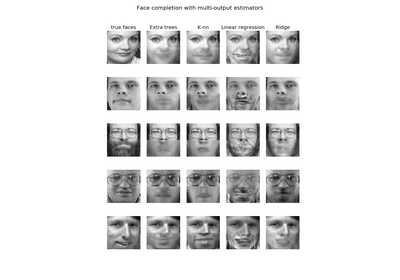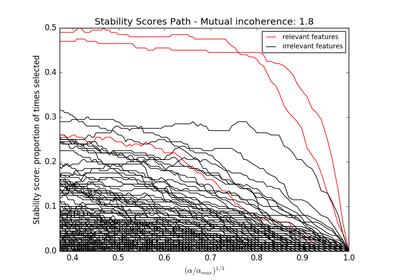3.2.4.3.4. sklearn.ensemble.ExtraTreesRegressor¶
-
class
sklearn.ensemble.ExtraTreesRegressor(n_estimators=10, criterion='mse', max_depth=None, min_samples_split=2, min_samples_leaf=1, min_weight_fraction_leaf=0.0, max_features='auto', max_leaf_nodes=None, min_impurity_split=1e-07, bootstrap=False, oob_score=False, n_jobs=1, random_state=None, verbose=0, warm_start=False)[source]¶ An extra-trees regressor.
This class implements a meta estimator that fits a number of randomized decision trees (a.k.a. extra-trees) on various sub-samples of the dataset and use averaging to improve the predictive accuracy and control over-fitting.
Read more in the User Guide.
Parameters: n_estimators : integer, optional (default=10)
The number of trees in the forest.
criterion : string, optional (default=”mse”)
The function to measure the quality of a split. Supported criteria are “mse” for the mean squared error, which is equal to variance reduction as feature selection criterion, and “mae” for the mean absolute error.
New in version 0.18: Mean Absolute Error (MAE) criterion.
max_features : int, float, string or None, optional (default=”auto”)
The number of features to consider when looking for the best split:
- If int, then consider max_features features at each split.
- If float, then max_features is a percentage and int(max_features * n_features) features are considered at each split.
- If “auto”, then max_features=n_features.
- If “sqrt”, then max_features=sqrt(n_features).
- If “log2”, then max_features=log2(n_features).
- If None, then max_features=n_features.
Note: the search for a split does not stop until at least one valid partition of the node samples is found, even if it requires to effectively inspect more than
max_featuresfeatures.max_depth : integer or None, optional (default=None)
The maximum depth of the tree. If None, then nodes are expanded until all leaves are pure or until all leaves contain less than min_samples_split samples.
min_samples_split : int, float, optional (default=2)
The minimum number of samples required to split an internal node:
- If int, then consider min_samples_split as the minimum number.
- If float, then min_samples_split is a percentage and ceil(min_samples_split * n_samples) are the minimum number of samples for each split.
Changed in version 0.18: Added float values for percentages.
min_samples_leaf : int, float, optional (default=1)
The minimum number of samples required to be at a leaf node:
- If int, then consider min_samples_leaf as the minimum number.
- If float, then min_samples_leaf is a percentage and ceil(min_samples_leaf * n_samples) are the minimum number of samples for each node.
Changed in version 0.18: Added float values for percentages.
min_weight_fraction_leaf : float, optional (default=0.)
The minimum weighted fraction of the sum total of weights (of all the input samples) required to be at a leaf node. Samples have equal weight when sample_weight is not provided.
max_leaf_nodes : int or None, optional (default=None)
Grow trees with
max_leaf_nodesin best-first fashion. Best nodes are defined as relative reduction in impurity. If None then unlimited number of leaf nodes.min_impurity_split : float, optional (default=1e-7)
Threshold for early stopping in tree growth. A node will split if its impurity is above the threshold, otherwise it is a leaf.
New in version 0.18.
bootstrap : boolean, optional (default=False)
Whether bootstrap samples are used when building trees.
oob_score : bool, optional (default=False)
Whether to use out-of-bag samples to estimate the R^2 on unseen data.
n_jobs : integer, optional (default=1)
The number of jobs to run in parallel for both fit and predict. If -1, then the number of jobs is set to the number of cores.
random_state : int, RandomState instance or None, optional (default=None)
If int, random_state is the seed used by the random number generator; If RandomState instance, random_state is the random number generator; If None, the random number generator is the RandomState instance used by np.random.
verbose : int, optional (default=0)
Controls the verbosity of the tree building process.
warm_start : bool, optional (default=False)
When set to
True, reuse the solution of the previous call to fit and add more estimators to the ensemble, otherwise, just fit a whole new forest.Attributes: estimators_ : list of DecisionTreeRegressor
The collection of fitted sub-estimators.
feature_importances_ : array of shape = [n_features]
The feature importances (the higher, the more important the feature).
n_features_ : int
The number of features.
n_outputs_ : int
The number of outputs.
oob_score_ : float
Score of the training dataset obtained using an out-of-bag estimate.
oob_prediction_ : array of shape = [n_samples]
Prediction computed with out-of-bag estimate on the training set.
See also
sklearn.tree.ExtraTreeRegressor- Base estimator for this ensemble.
RandomForestRegressor- Ensemble regressor using trees with optimal splits.
References
[R160] P. Geurts, D. Ernst., and L. Wehenkel, “Extremely randomized trees”, Machine Learning, 63(1), 3-42, 2006. Methods
apply(X)Apply trees in the forest to X, return leaf indices. decision_path(X)Return the decision path in the forest fit(X, y[, sample_weight])Build a forest of trees from the training set (X, y). fit_transform(X[, y])Fit to data, then transform it. get_params([deep])Get parameters for this estimator. predict(X)Predict regression target for X. score(X, y[, sample_weight])Returns the coefficient of determination R^2 of the prediction. set_params(\*\*params)Set the parameters of this estimator. transform(\*args, \*\*kwargs)DEPRECATED: Support to use estimators as feature selectors will be removed in version 0.19. -
__init__(n_estimators=10, criterion='mse', max_depth=None, min_samples_split=2, min_samples_leaf=1, min_weight_fraction_leaf=0.0, max_features='auto', max_leaf_nodes=None, min_impurity_split=1e-07, bootstrap=False, oob_score=False, n_jobs=1, random_state=None, verbose=0, warm_start=False)[source]¶
-
apply(X)[source]¶ Apply trees in the forest to X, return leaf indices.
Parameters: X : array-like or sparse matrix, shape = [n_samples, n_features]
The input samples. Internally, its dtype will be converted to
dtype=np.float32. If a sparse matrix is provided, it will be converted into a sparsecsr_matrix.Returns: X_leaves : array_like, shape = [n_samples, n_estimators]
For each datapoint x in X and for each tree in the forest, return the index of the leaf x ends up in.
-
decision_path(X)[source]¶ Return the decision path in the forest
New in version 0.18.
Parameters: X : array-like or sparse matrix, shape = [n_samples, n_features]
The input samples. Internally, its dtype will be converted to
dtype=np.float32. If a sparse matrix is provided, it will be converted into a sparsecsr_matrix.Returns: indicator : sparse csr array, shape = [n_samples, n_nodes]
Return a node indicator matrix where non zero elements indicates that the samples goes through the nodes.
n_nodes_ptr : array of size (n_estimators + 1, )
The columns from indicator[n_nodes_ptr[i]:n_nodes_ptr[i+1]] gives the indicator value for the i-th estimator.
-
feature_importances_¶ - Return the feature importances (the higher, the more important the
- feature).
Returns: feature_importances_ : array, shape = [n_features]
-
fit(X, y, sample_weight=None)[source]¶ Build a forest of trees from the training set (X, y).
Parameters: X : array-like or sparse matrix of shape = [n_samples, n_features]
The training input samples. Internally, its dtype will be converted to
dtype=np.float32. If a sparse matrix is provided, it will be converted into a sparsecsc_matrix.y : array-like, shape = [n_samples] or [n_samples, n_outputs]
The target values (class labels in classification, real numbers in regression).
sample_weight : array-like, shape = [n_samples] or None
Sample weights. If None, then samples are equally weighted. Splits that would create child nodes with net zero or negative weight are ignored while searching for a split in each node. In the case of classification, splits are also ignored if they would result in any single class carrying a negative weight in either child node.
Returns: self : object
Returns self.
-
fit_transform(X, y=None, **fit_params)[source]¶ Fit to data, then transform it.
Fits transformer to X and y with optional parameters fit_params and returns a transformed version of X.
Parameters: X : numpy array of shape [n_samples, n_features]
Training set.
y : numpy array of shape [n_samples]
Target values.
Returns: X_new : numpy array of shape [n_samples, n_features_new]
Transformed array.
-
get_params(deep=True)[source]¶ Get parameters for this estimator.
Parameters: deep : boolean, optional
If True, will return the parameters for this estimator and contained subobjects that are estimators.
Returns: params : mapping of string to any
Parameter names mapped to their values.
-
predict(X)[source]¶ Predict regression target for X.
The predicted regression target of an input sample is computed as the mean predicted regression targets of the trees in the forest.
Parameters: X : array-like or sparse matrix of shape = [n_samples, n_features]
The input samples. Internally, its dtype will be converted to
dtype=np.float32. If a sparse matrix is provided, it will be converted into a sparsecsr_matrix.Returns: y : array of shape = [n_samples] or [n_samples, n_outputs]
The predicted values.
-
score(X, y, sample_weight=None)[source]¶ Returns the coefficient of determination R^2 of the prediction.
The coefficient R^2 is defined as (1 - u/v), where u is the regression sum of squares ((y_true - y_pred) ** 2).sum() and v is the residual sum of squares ((y_true - y_true.mean()) ** 2).sum(). Best possible score is 1.0 and it can be negative (because the model can be arbitrarily worse). A constant model that always predicts the expected value of y, disregarding the input features, would get a R^2 score of 0.0.
Parameters: X : array-like, shape = (n_samples, n_features)
Test samples.
y : array-like, shape = (n_samples) or (n_samples, n_outputs)
True values for X.
sample_weight : array-like, shape = [n_samples], optional
Sample weights.
Returns: score : float
R^2 of self.predict(X) wrt. y.
-
set_params(**params)[source]¶ Set the parameters of this estimator.
The method works on simple estimators as well as on nested objects (such as pipelines). The latter have parameters of the form
<component>__<parameter>so that it’s possible to update each component of a nested object.Returns: self :
-
transform(*args, **kwargs)[source]¶ DEPRECATED: Support to use estimators as feature selectors will be removed in version 0.19. Use SelectFromModel instead.
Reduce X to its most important features.
Usescoef_orfeature_importances_to determine the most important features. For models with acoef_for each class, the absolute sum over the classes is used.Parameters: X : array or scipy sparse matrix of shape [n_samples, n_features]
The input samples.
- threshold : string, float or None, optional (default=None)
The threshold value to use for feature selection. Features whose importance is greater or equal are kept while the others are discarded. If “median” (resp. “mean”), then the threshold value is the median (resp. the mean) of the feature importances. A scaling factor (e.g., “1.25*mean”) may also be used. If None and if available, the object attribute
thresholdis used. Otherwise, “mean” is used by default.
Returns: X_r : array of shape [n_samples, n_selected_features]
The input samples with only the selected features.



